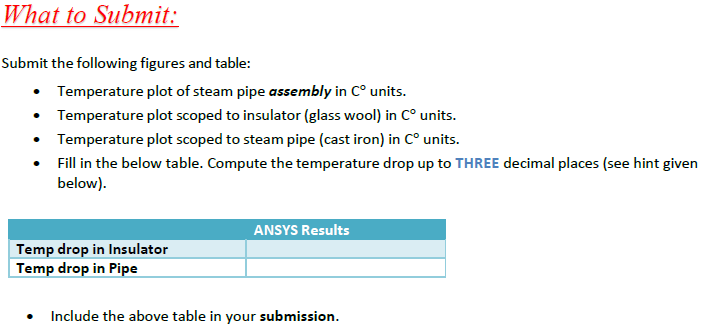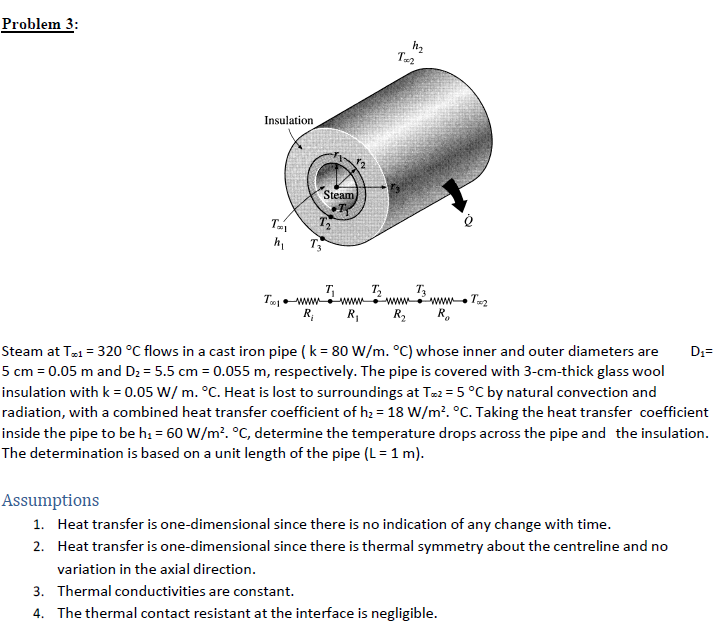What to Submit: Submit the following figures and table: • Temperature plot of steam pipe assembly in C° units. Temperature plot scoped to insulator (glass wool) in C° units. • Temperature plot scoped to steam pipe (cast iron) in C° units. • Fill in the below table. Compute the temperature drop up to THREE decimal places (see hint given below). Temp drop in Insulator Temp drop in Pipe ANSYS Results • Include the above table in your submission. Problem 3: Insulation To=1 Toowwww Steam Tx2 T₂ T3 www www R₁ R₁ R₂ www.T R₂ Steam at Tx1 = 320 °C flows in a cast iron pipe (k = 80 W/m. °C) whose inner and outer diameters are 5 cm = 0.05 m and D₂ = 5.5 cm = 0.055 m, respectively. The pipe is covered with 3-cm-thick glass wool insulation with k = 0.05 W/m. °C. Heat is lost to surroundings at T2 = 5 °C by natural convection and radiation, with a combined heat transfer coefficient of h₂ = 18 W/m². °C. Taking the heat transfer coefficient inside the pipe to be h₁ = 60 W/m². °C, determine the temperature drops across the pipe and the insulation. The determination is based on a unit length of the pipe (L = 1 m). Assumptions 1. Heat transfer is one-dimensional since there is no indication of any change with time. 2. Heat transfer is one-dimensional since there is thermal symmetry about the centreline and no variation in the axial direction. 3. Thermal conductivities are constant. 4. The thermal contact resistant at the interface is negligible. D₁=
What to Submit: Submit the following figures and table: • Temperature plot of steam pipe assembly in C° units. Temperature plot scoped to insulator (glass wool) in C° units. • Temperature plot scoped to steam pipe (cast iron) in C° units. • Fill in the below table. Compute the temperature drop up to THREE decimal places (see hint given below). Temp drop in Insulator Temp drop in Pipe ANSYS Results • Include the above table in your submission. Problem 3: Insulation To=1 Toowwww Steam Tx2 T₂ T3 www www R₁ R₁ R₂ www.T R₂ Steam at Tx1 = 320 °C flows in a cast iron pipe (k = 80 W/m. °C) whose inner and outer diameters are 5 cm = 0.05 m and D₂ = 5.5 cm = 0.055 m, respectively. The pipe is covered with 3-cm-thick glass wool insulation with k = 0.05 W/m. °C. Heat is lost to surroundings at T2 = 5 °C by natural convection and radiation, with a combined heat transfer coefficient of h₂ = 18 W/m². °C. Taking the heat transfer coefficient inside the pipe to be h₁ = 60 W/m². °C, determine the temperature drops across the pipe and the insulation. The determination is based on a unit length of the pipe (L = 1 m). Assumptions 1. Heat transfer is one-dimensional since there is no indication of any change with time. 2. Heat transfer is one-dimensional since there is thermal symmetry about the centreline and no variation in the axial direction. 3. Thermal conductivities are constant. 4. The thermal contact resistant at the interface is negligible. D₁=
Principles of Heat Transfer (Activate Learning with these NEW titles from Engineering!)
8th Edition
ISBN:9781305387102
Author:Kreith, Frank; Manglik, Raj M.
Publisher:Kreith, Frank; Manglik, Raj M.
Chapter7: Forced Convection Inside Tubes And Ducts
Section: Chapter Questions
Problem 7.27P
Related questions
Question

Transcribed Image Text:What to Submit:
Submit the following figures and table:
• Temperature plot of steam pipe assembly in C° units.
Temperature plot scoped to insulator (glass wool) in C° units.
• Temperature plot scoped to steam pipe (cast iron) in C° units.
•
Fill in the below table. Compute the temperature drop up to THREE decimal places (see hint given
below).
Temp drop in Insulator
Temp drop in Pipe
ANSYS Results
• Include the above table in your submission.

Transcribed Image Text:Problem 3:
Insulation
To=1
Toowwww
Steam
Tx2
T₂ T3
www www
R₁ R₁ R₂
www.T
R₂
Steam at Tx1 = 320 °C flows in a cast iron pipe (k = 80 W/m. °C) whose inner and outer diameters are
5 cm = 0.05 m and D₂ = 5.5 cm = 0.055 m, respectively. The pipe is covered with 3-cm-thick glass wool
insulation with k = 0.05 W/m. °C. Heat is lost to surroundings at T2 = 5 °C by natural convection and
radiation, with a combined heat transfer coefficient of h₂ = 18 W/m². °C. Taking the heat transfer coefficient
inside the pipe to be h₁ = 60 W/m². °C, determine the temperature drops across the pipe and the insulation.
The determination is based on a unit length of the pipe (L = 1 m).
Assumptions
1. Heat transfer is one-dimensional since there is no indication of any change with time.
2.
Heat transfer is one-dimensional since there is thermal symmetry about the centreline and no
variation in the axial direction.
3. Thermal conductivities are constant.
4. The thermal contact resistant at the interface is negligible.
D₁=
AI-Generated Solution
Unlock instant AI solutions
Tap the button
to generate a solution
Recommended textbooks for you

Principles of Heat Transfer (Activate Learning wi…
Mechanical Engineering
ISBN:
9781305387102
Author:
Kreith, Frank; Manglik, Raj M.
Publisher:
Cengage Learning

Principles of Heat Transfer (Activate Learning wi…
Mechanical Engineering
ISBN:
9781305387102
Author:
Kreith, Frank; Manglik, Raj M.
Publisher:
Cengage Learning